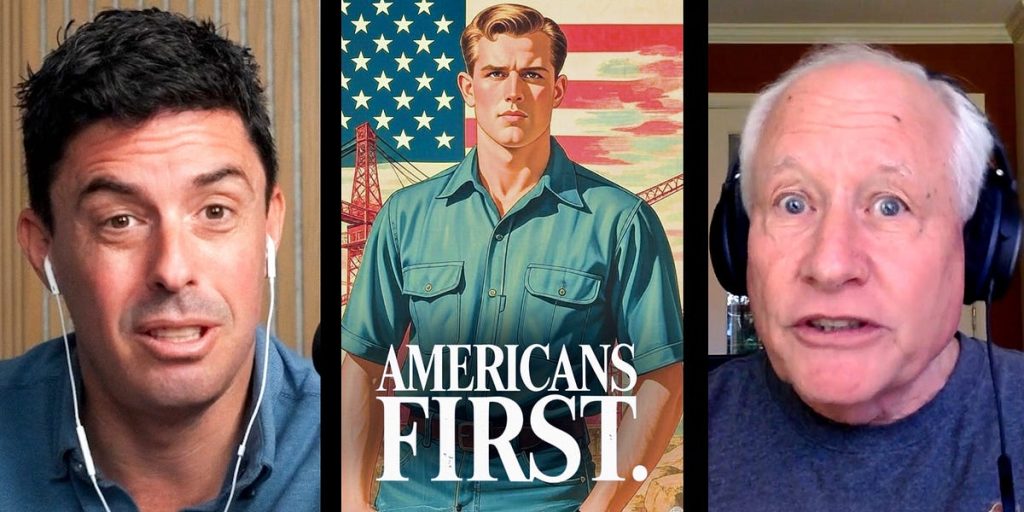Listen to the article
Tim Miller and Bill Kristol Criticize “White Nationalist” Labor Department Ad and Tucker Carlson’s Fuentes Interview
In a scathing critique, political commentators Tim Miller and Bill Kristol have taken aim at what they describe as a “bizarre” advertising campaign from the Trump administration’s Department of Labor, characterizing it as a “white nationalist” throwback filled with imagery reminiscent of the 1950s.
The commentators, in their latest discussion for The Bulwark, expressed concern over the aesthetic choices and messaging in the government agency’s campaign, which they suggest evokes an era of American life that predates civil rights advancements and modern workplace diversity.
The discussion comes amid growing scrutiny of political messaging as the administration faces criticism from various quarters about its approach to labor issues and demographic representation in official communications. Labor Department advertising traditionally focuses on worker protections, employment statistics, and regulatory matters, making this stylistic departure particularly noteworthy to observers.
Miller and Kristol didn’t limit their criticism to government advertising. They also addressed what they termed a “disturbing” recent interview between Fox News host Tucker Carlson and controversial streamer Nick Fuentes. Fuentes has gained notoriety for Holocaust denial statements and expressions of admiration for Soviet dictator Joseph Stalin, making his appearance on a mainstream conservative platform particularly controversial.
Carlson, whose primetime show reaches millions of viewers nightly, has faced backlash in the past for platforming figures from the far right. Media watchdogs have previously raised concerns about the normalization of extremist viewpoints through such high-profile interviews, with critics suggesting they provide legitimacy to fringe ideologies.
The pairing of these two topics in Miller and Kristol’s discussion points to what they perceive as a troubling pattern in contemporary right-wing messaging. Both commentators have established themselves as conservative critics of the Trump administration and its allies, frequently raising alarms about what they see as the movement’s drift toward ethnonationalist rhetoric and imagery.
The Labor Department ad campaign represents a notable shift in government communication strategy. Federal agencies typically maintain relatively neutral, policy-focused messaging that transcends partisan divides. However, under the current administration, several departments have adopted more politically charged communication styles that align with the President’s broader messaging strategy.
Media and political communication experts note that government advertising choices reflect more than aesthetic preferences—they signal policy priorities and cultural values. The nostalgic framing criticized by Miller and Kristol may resonate with certain segments of the electorate while alienating others, highlighting the increasingly polarized nature of even seemingly routine government functions.
The Carlson-Fuentes interview, meanwhile, illustrates the evolving landscape of conservative media, where boundaries between mainstream platforms and controversial internet personalities have become increasingly porous. Fuentes, who rose to prominence primarily through streaming and social media rather than traditional channels, represents a new generation of right-wing commentators whose extreme positions would once have kept them firmly outside mainstream discourse.
Miller and Kristol’s discussion forms part of their ongoing commentary series for The Bulwark, a political analysis outlet founded by conservative critics of the Trump administration. Their conversation is available in both video and audio formats exclusively for Bulwark+ subscribers, reflecting the growing trend toward premium subscription models in political media.
As the political landscape continues to evolve, these discussions highlight the increasing importance of visual symbolism and media platforming choices in shaping public discourse. The controversy surrounding both the Labor Department campaign and Carlson’s interview choices demonstrates how aesthetic and editorial decisions have become central battlegrounds in America’s ongoing cultural and political debates.
Verify This Yourself
Use these professional tools to fact-check and investigate claims independently
Reverse Image Search
Check if this image has been used elsewhere or in different contexts
Ask Our AI About This Claim
Get instant answers with web-powered AI analysis
Related Fact-Checks
See what other fact-checkers have said about similar claims
Want More Verification Tools?
Access our full suite of professional disinformation monitoring and investigation tools




11 Comments
The Labor Dept’s ad campaign is a worrying step in the wrong direction. Government messaging should champion modern values of inclusivity, not outdated aesthetics.
Agreed, this is a concerning development that deserves scrutiny. Hopefully the administration will reconsider this approach and refocus on core labor issues.
The Labor Dept’s ad campaign seems like a concerning step backwards. Government communications need to reflect today’s diverse, inclusive workplaces, not outdated imagery.
Agreed, this is a troubling development. Hopefully there will be a rethinking of the approach to avoid further alienating workers and the public.
Concerning to see the Trump administration’s Labor Dept ads evoking a bygone era before civil rights progress. Inclusive, worker-focused messaging should be the priority.
Concerning that the Trump administration’s Labor Dept ads evoke a bygone era before civil rights advances. Inclusive, modern messaging should be the priority for government agencies.
Concerning to see the Trump administration using questionable messaging and imagery in their Labor Dept ads. It’s important government communications reflect modern workplace diversity and values.
Agree, the 1950s-style aesthetics seem like a troubling throwback. Curious to learn more about the motivations behind this campaign.
The Labor Dept’s advertising campaign raises eyebrows. Revisiting the past at the expense of inclusivity and progress is worrying. Scrutiny of political messaging is warranted.
It’s disappointing to see this kind of regressive approach from the administration. Hopefully they’ll course-correct and focus on promoting worker protections and rights instead.
Troubling to see the Trump administration’s Labor Dept ads harkening back to a less inclusive past. Workplace diversity and worker protections should be the focus, not regressive imagery.